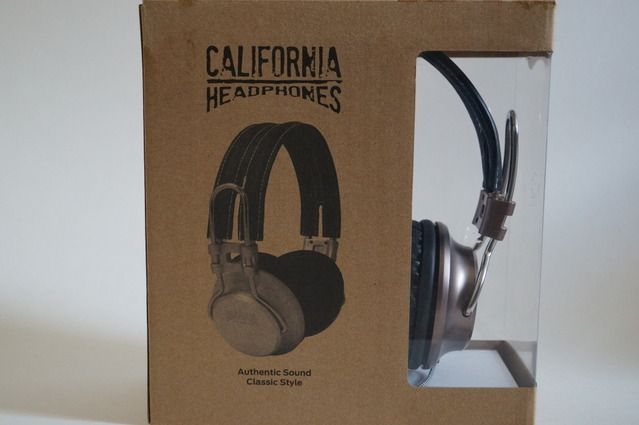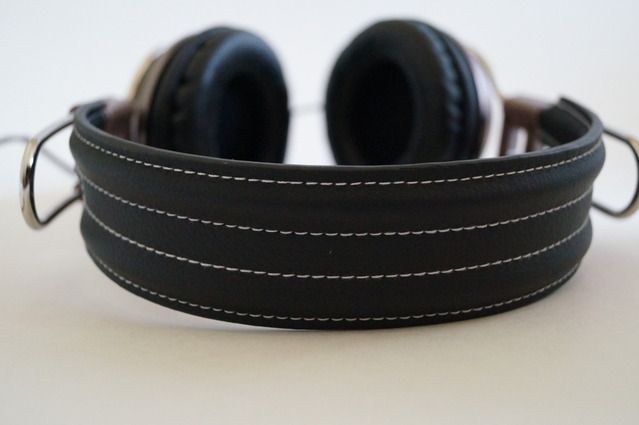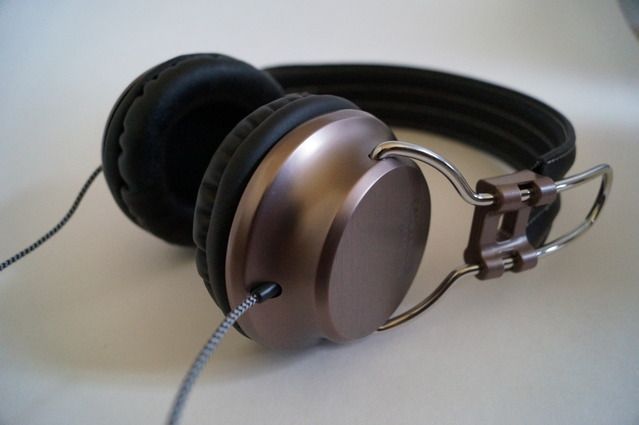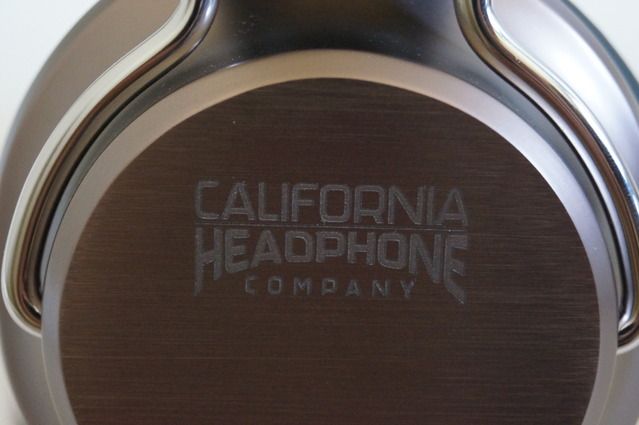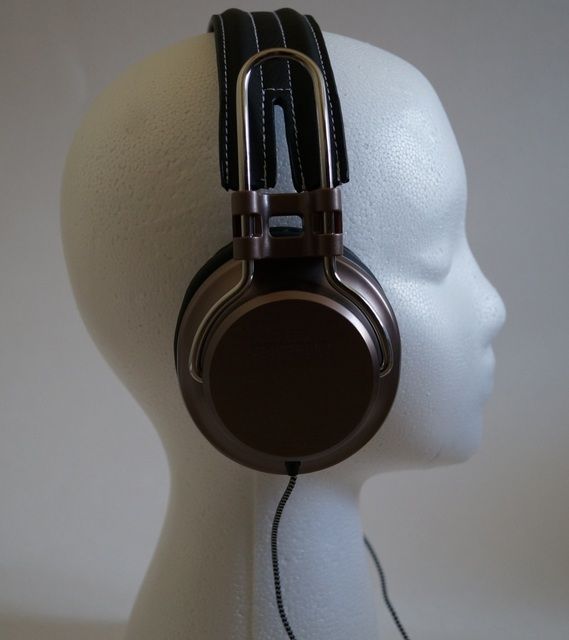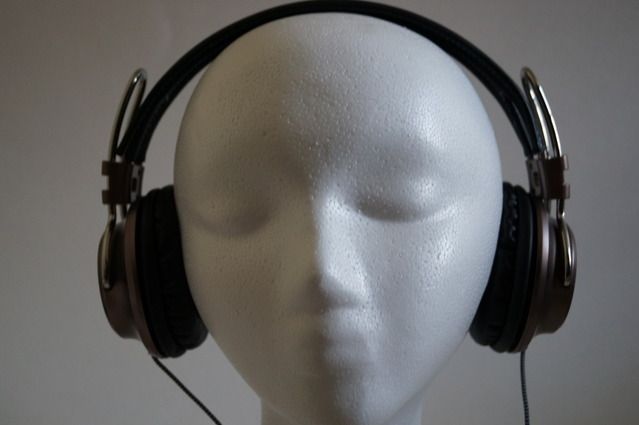So who likes new companies?! California Headphones is a new headphone brand created by Tim Hickman, the creator of Fanny Wang. But it’s quite a bit more threatening to the “big” headphone manufacturers than his previous endeavor. The Laredos are the pair I’m reviewing today, and if the production pairs sound as good as this pre-production pair, AiAiAi, Klipsch, Sony, and others will need to step up their game for the consumer-type headphone. Full disclosure: I was given a pre-production pair to keep, but I’m usually more positive about things that I buy myself, so yeah, there’s not really any bias here.
The Laredos are packaged in a Fischer Audio-esque cardboard box. It’s not the fanciest packaging ever, but it’s money saved for us, which is definitely okay. On the back is an interesting tidbit of information that not very many companies tell us. There’s a frequency response chart!
Inside the box, you find the headphones. That’s it; no case or adapter, but I can only assume it’s to emphasize the Laredo’s durability.
California Headphones advertises its headphones as being able to “last forever.” While that probably won’t happen–cables tend to not love working for very long if subjected to abuse–they definitely won’t snap in two like the headphones they’re competing against. (Hint, one of their slogans is “Stop pretending to be a rap star.”) There’s only one piece of what I think is plastic on the headphones. The rest is metal. They’re basically on the same level as the Sony V6 in likelihood of post-apocalyptical survival. Unless you’re the Hulk, you’re probably not going to break these.
To be completely frank, I think the Laredos have the nicest design of any sub $100 headphone, and it’s the type of headphone you need to actually hold to understand that these are freaking gorgeous. The cups are also made of metal, which is something of an oddity for this cheap. “California Headphone Company” is silkscreened onto the brushed side of the cup, which is a nice touch.
Earpads are apparently made of leather (they smell like it), and are moderately cushiony, but not comfy enough that you’d be able to wear them for any more than four hours without at least slight discomfort. The headband is definitely made of leather, but not padded. Their only padding seems to be the small amount of squishiness of the leather that covers the headband. The cable is a cloth-covered affair, similar to Audio Technica’s A-series headphones, but seems to infringe on the patents that zebras have filed for their hair. It also isn’t thick enough to inspire confidence, but it probably won’t break unless you use the cable to save someone from falling off a cliff.
There’s also a cool bit of kit on the cable itself. Like the Fanny Wangs that came before it, the Laredos have the Duojack, which is basically a splitter on the cable itself. It’s kind of cool, but remember that if you split the signal, you get half the power, and the headphone doesn’t sound quite as good. …but if you’re with a special someone that you want to share music with, that’s not much of an issue anyway.
Unfortunately, the Laredos don’t fold up or swivel, but they are neckable, if that’s your prerogative. You also won’t have to worry about them breaking if you toss them in a backpack, so at least there’s that.
Fit isn’t too much of an issue for my…rather large head (my hat size is 60cm or 7½). The adjusters are very generous; there’s still about 3/4th of an inch left if someone has more of a melon-head than I do. Clamp is moderately tight; headbanging is definitely achievable. I do wish the cups were able to tilt sideways though, for the sake of comfort. As I said before, they’re not the comfiest after a few hours, but if you toughen up, using them for longer than that shouldn’t be an issue; I’m just spoiled by my other circumaurals. Despite the tough build, they really aren’t that heavy. They actually weigh about as much as my Klipsch Image Ones–I was going to compare my Image Ones to the Laredos later on, but to save time: The only thing I like about the Image One is the case.
Noise isolation is about average. Even with music on, I can still slightly hear a vacuum cleaner whirring in the background, so I’d expect a little subway noise would also come through, but not so much that they’d be unusable in that situation.
My review of the sound will be split into two parts: one with the mindset of the target market of this headphone, taking note of what your average 15-25 year old will hear in this (basically all praise); and one as the audio nerd that I am, pointing out its flaws with a finer-toothed comb.
As every portable headphone should be, the Laredos have both a DAP friendly resistance (32ohm) and sensitivity (123dB/mW). For the “consumer” section of this review, I’ll be using my just my phone as a source, which is an HTC Amaze.
So you’re in the market for a new headphone, want something that sounds good, and don’t want to look like a t00l? There really aren’t very many options for you, especially under $100. The Creative Aurvana Live! sounds fantastic, but they’re kind of bulky and definitely don’t look as good as they sound. The V-Moda Crossfade LP looks cool, but they aren’t great with anything other than electronic and rap. The Sony V6 sounds decent, but doesn’t look that cool unless you’re going for “studio engineer.” Now, looks aren’t everything, but something that looks nice while sounding good allows you to have your cake and eat it too. That’s where the Laredos step in.
The Laredos have an incredibly relaxing sound signature that’s a world of difference compared to stock headphones. They have a very warm sound signature that’s very easy to chill out to, while retaining a lot of details that are lost on inferior headphones—a hard combination. Listening to The Tallest Man on Earth (the closest I’ll get to country), I was able to pick apart individual strums and able to figure out what each chord was in certain songs, which is more than I expected from the Laredo’s warmness, as it’s the type that usually clouds details for the sake of having an agreeable sound signature.
Vocals are advertised to be the center of the sound, and I have to agree. Of course, they’re not anywhere near the level of even my (cheaper, but modified to the max) Fostex T50RP, but when compared to its competition, they have a very different presentation: they’re prominent, a rare trait in the fashion-forward headphone world that tends to put bass first, midrange last. Thanks to the very warm sound, electric guitars tend to have a very vintage-y sound that sounds more fitting for the last century, but metal certainly doesn’t sound horrible—on the contrary!
I’m not too sure why these aren’t described as bassy on the website, because they definitely are, and the graphs show it. They’re certainly not as bassy as Beats, but they’re bassier than my AKG K181’s, which are already pretty bassy. There’s a good reason for that though. The aim of the Laredos is for a warm sound—California’s pretty warm, so I guess that makes for a “California sound”—that works with most genres. Because of the very predictable, lax sound, there isn’t room to complain too much about the sound lacking in any genre despite the disparities different genres have. A warm sound is the easiest way to do that, and for people entering the headphone game for the first time, it’s the best sound signature to start with, because it simply works with basically every genre the average person likes. Tim Hickman (owner of California Headphones) uses country, rock, and alternative because, well, they’re the most common genres for people to like other than rap and electronic, and the Laredo’s lush sound signature is great for accentuating the grungy sound of most rock and the earthy vocals of country. I do have a bit of trouble recommending them to music that prefers bright headphones, such as a lot of music involving soprano singers, as bright headphones really bring out the best in such women, but since there literally are no bright headphones in the sub-$100 portable world, as far as I know…
Treble, for newbies, is a particularly hard topic to cover, since treble seems to be missing from every entry level headphone, so anything better will be foreign to them. Put simply, it’s…okay. It’s really nothing to write home about sadly, but for the price point, you can’t complain too much. It does get harsh at times though, and sometimes it’s recessed to the point of “veiling” the sound.
In short, I really can’t think of a better headphone for someone new to the headphone world to start with. The Laredos are very far from perfect, but their sound is such that it’s very hard to hate since it does little wrong, their build is nothing short of fantastic, at any price point, and how can you deny those looks? The combination of all these things makes for, basically, The headphone for someone that doesn’t want to eventually spend thousands of dollars in audio gear, trying to find the most realistic sound possible.
However, when I say they’re far from perfect, really do have their faults. Here’s the part that may make Tim wince. Everything I say here is basically to appease the people that must find something wrong with every pair headphones, because nice things don’t exist. And there’s a part of me that feels kind of like a shill, so to clear my conscience, I’m going to scrutinize everything to an obnoxious degree. It’ll be my dose of snark for the day. I’m using a significantly nicer DAP for this section: the NaNite N2.
Treble…the treble, after using the far more expensive Sony SA5000 for two months, sounds kind of…bad. As shown on the frequency response graph that was generously given to us, it’s peaky and recessed at the same time. It’s actually quite veiled 50% of the time, and harsh the other 50%. Also, there’s some ringing—a lot of ringing. Oh, and there’s some sibilance on some recordings.
A lot of the midrange is recessed; Tim is well aware of this, but as most people know, making a small, closed headphone on a budget is hard. To make it harder, the Laredos probably aren’t very cheap to build either due to the metal and leather everywhere. But anyway, have any of you ever tried a headphone from the 70’s? Yeah the midrange is kind of like that. It, like the treble, is peaky and plain wonky. Vocals are the most obvious aspect that fall curse to this weird tuning. They’re quite forward in comparison to the rest of the midrange, but sound incredibly weird and nasal. It works with some music though. That probably won’t be too hard to fix though with a minimal amount of tinkering.
Their bass also has some issues. If you aren’t a basshead, listening to an electric bass will get kind of irritating. For some reason, electric basses tend to overshadow vocals. Impact can also be a bit much for people used to a neutral sound. Oh, and they only go down to 30hz.
Soundstage? Well…you can probably predict there’s not much. Nor is there any air. There’s more echo than anything. Positioning isn’t dreadful though. Detail is…okay. It’s on par with the Image One.
So yes, the Laredos have many flaws, but I could also rant about every other sub-$100 headphone. The point is, Tim Hickman has released what I can only presume would be bigger than Beats if he had more money to market them (He talks more about design because more people care about that more than they care about sound, which is backwards, but since the Beats invasion, that’s the new norm. And besides, the frequency response probably explains more than he would have been able to describe in a short video). Here’s a little quote he talked to me about.
“To build a business we need to address the addressable part of the market. 25% of ALL headphones sold are under $19, 48% are under $49, and 3/4s of all headphones sold are under $150. This is where a new company needs to gain traction if it’s going to become a player and if it is going to develop the resources to make greater and greater advancements. And besides…we really like introducing higher end audio to people who have not experienced it before. That’s cool.
From a high end perspective, folks claim Beats are all style and little substance. But I’d actually make the claim that they have done more to bring high end audio to the masses than anyone else. 5 Years ago the white Apple Ear Bud was mass market high-end….with bad audio. Then Skull Candy did its thing for Skate and Surf from a pure style and lifestyle perspective. Beats did up the level of audio compared to the market movers before them (Slightly). So in that trend, we are trying to push both sides of the equation. Both are important as the end result is helping consumer better enjoy their headphone experience. If you are super jazzed about how you’re rocking your new headphones it is going to affect how you perceive the music.”
Of course they’re not the best headphones ever; they’re one hundred dollars. That’s it. That’s peanuts compared to a lot of the new stuff coming out. And they’re made of nice materials. They had to make tradeoffs to appeal to the general consumer. There are better sounding options at the price, like the aforementioned Fostex T50RP, but they’re basically impossible to market to anyone. Sure, Tim could make these sound better if he added some damping, but would the average consumer that buys these even tell the difference? Probably not. It’d only necessitate an inflated price, and heck, we’d probably do a better job anyways since we can use ghetto’ed modding materials, like modeling clay, that California Headphones wouldn’t be able to use. I’ve been reading a lot of skepticism and dissuasion concerning these headphones, and I don’t really think that makes too much sense. If we as a community dislike Beats (or other all style, no substance headphones), wouldn’t it be smart to support other, smaller companies—especially those that will listen? If their products are subpar, we have every right to barge right into the company’s webpage and give them an eyeful of what we think, and how they can improve their sound. T
he Laredos are infinitely better than Fanny Wangs in both technical ability and pure enjoyment, so Tim’s obviously listened. My only real gripe is its midrange, but that’s only because I’ve been exposed to so many other headphones with fantastic midranges. Would I buy my own pair? Probably, only because they combine a lot of features I need in a portable headphone, and their problems seem like they wouldn’t be impossible to tame. Besides, there really aren’t very many other cheap options for a bulletproof portable headphone other than the Sony V6, which I like a little less than these Laredos.
Obviously, if you have any superior gear, you’ll find these have tons of aural problems with the Laredos, but these should at least be given a chance by anyone looking for a durable, stylish, portable headphone under $100. I mean, how many of those are there other than the Audio Technica ES7, the basstastic V-Moda Crossfade LP, and the technically inferior and more fragile AKG K518? I have to give these some leeway because while they’re definitely an improvement to the weird sounding Wangs, they still need to impress the vain kids that are accustomed to a very artificial sound, due to some very artificial music. I honestly can’t think of a better alternative in that respect. And thankfully, these aren’t falsely advertised to be the second coming of audio; they, mostly, sound like they’re advertised, which is a rich, warm sound with forward vocals. While the vocals may not sound perfect, it’s not too bad for a first effort at a sub $100 headphone. I wish not only Tim, but every other company that actually cares about how music sounds, the best of luck.
If you act before August 12, 2012, you can get $25 off a pair of Laredos at Kickstarter <—- Click!


